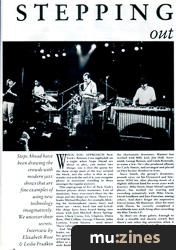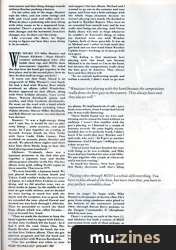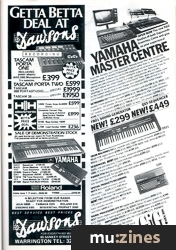Magazine Archive
Home -> Magazines -> Issues -> Articles in this issue -> View
Stepping Out | |
Steps AheadArticle from Music Technology, January 1987 | |
What do you get when you cross brilliant musicianship, technological wizardry and one of the brightest line-ups in modern jazz? Answer: Steps Ahead. Interview by Liz Rose and Leslie Fradkin.
Steps Ahead have been drawing the crowds with modern jazz shows that are fine examples of using new technology imaginatively. We uncover their secrets.

WHEN YOU APPROACH New York's Bottom Line nightclub on a night when Steps Ahead are about to play, you notice two things: one is that the queue for the show wraps most of the way around the block, and the other is that as you wander towards the end of it, you recognise plenty of musicians standing in there amongst the regular punters.
This supergroup of five of New York's hottest players draws musicians. Lots of musicians. Sure, everyone's there for the chops and the chops are there. There's co-leader Michael Brecker, for example, blowing his Steinerphone (more later) and tenor sax - sweet, hard, fast and lyrical. His chops have been heard biting into music with Joni Mitchell, Bruce Springsteen, Chick Corea, Eric Clapton, Diana Ross, Phil Collins, George Clinton, John Lennon, Frank Sinatra - need more? There's plenty.
And Michael Manieri, the other co-leader, on MIDI vibraphones and synths, has graced a few dates with his playing, arranging or producing. Starting with his debut as a 17-year old vibraphonist who stole Buddy Rich's comeback show from the charismatic drummer, Manieri has worked with Billy Joel, Jim Hall, Aerosmith, George Benson, and Linda Ronstadt, to name a few. He's also produced albums for Carly Simon, and arranged and played on Dire Straits' Brothers in Arms.
Steve Smith, the group's drummer, pounds away on his Dynacord and Simmons SDS5 kit, after playing music of a slightly different kind for seven years with Journey. Mike Stern, Steps Ahead's guitar player, has worked out touring and recording extensively with Miles Davis, David Sandborn and Jaco Pastorius, among others. And don't forget the impressive Darryl Jones, Mr Bassman. After his stint with Davis, he recently completed a worldwide tour with Sting after recording the Blue Turtles LP.
So there are chops galore. Enough to draw a sizeable and electric crowd. But there's one other big attraction when it comes to seeing this band. There's some technology going on here. I mean, there's Brecker with something that looks like a sawn-off clarinet (it's actually called a Steinerphone EWI) playing orchestral parts - and chords. How's he doing that? There's computer tape coming out of that instrument and that thing changes sounds without Brecker pushing a button.
On the other side of the stage, Manieri taps his vibes, and out come strings and bells and vocal pads and cellos and ice. When he plays a pulsating solo tune along with what seems to be a sequenced loop, surprise! There's a pause in the piece, the time changes and the harmonic structure changes, too. So there can't be a loop.
Like everyone else there, we began trying to figure out how they were doing it. So we asked...
WE SPOKE TO Mike Manieri and Dennis Alichwer - Steps Ahead's resident technological whiz who builds their rigs and MIDIs their instruments together. We asked the duo how the band got together in the first place, and in the second place, how do they do that stuff on stage, anyhow?
It turns out that Steps Ahead is an outgrowth of Mike Manieri's own band. He had a deal with Warner Bros which produced an album called Wanderlust. Brecker appeared on that album, along with Peter Erskine (drums), Tony Levin (bass), Warren Bernhardt (piano and synths), and Don Grolnick (keyboards). He went on the road with a band which represented that album including Omar Hakim (drums), Marcus Miller, Bernhardt, and Bob Mintzer on tenor sax and electric bass clarinet.
Manieri: "It was a high-energy thing and I said, boy it would be nice to play some bebop - some acoustic, real quiet music. So I put together an evening at Seventh Avenue South (in New York) with Steve Gadd, Eddie Gomez, Don Grolnick on acoustic piano, Brecker and myself. We played three nights and there were lines three blocks long to hear this band playing some standards."
"Musicians love playing with this band because the compositions really draw the best guys in the country. They always have and they always will."
Alichwer: "Evidently, there was a Japanese promoter in the club who put together a Japanese tour and double album project (Smokin' in the Pit). The live album went gold, selling 50,000 copies in three months. That was in 1979.
"We were basically a Japanese band. We just played Seventh Avenue South and Tokyo. Gadd couldn't make the next tour of Japan, so I asked Peter Erskine to come along, and we did another tour, two or three weeks in Japan. In the middle of the tour we got really serious, and we decided we were having so much fun with the music and the reception was so great that we extended the tour, played Hawaii and worked our way back through California. Then we proceeded to record the third Steps album which was called Paradox Live at Seventh Ave. South.
"Then we made the decision to keep the band together and we signed with Elektra. At that time Grolnick left the band - he'd had it with the road. Elaine Elias, Mrs Randy Brecker, joined the band; she was on that first Elektra album. Then she got married, pregnant and left the band and we replaced her with Warren Bernhardt.

Our last problem was when to tour and support this last album. Michael and I wanted to go out in the summer and tour Japan, and Peter was a little unhappy with the whole Steps situation because we weren't playing very much. He decided to go back to Weather Report. They were on an extended four-month tour and he was really into being out playing. And Victor Bailey (bass) was only in Steps whenever he couldn't do Zawinul's thing, so when Joe Zawinul went out with Weather Update, both of those guys left. It was up to Michael and I either to wait until they got back and use that band when Weather Update wasn't working, or to just go with new guys.
"My feeling is that musicians love playing with this band, not because Michael is in the band or I'm in the band, but because the compositions really draw the best guys in America. They always have and they always will.
"So we started auditioning people and within a month, I didn't want to go near my phone. We had hundreds of calls - guys from everywhere, from Europe had found out. It was really flattering.
"Steve Smith found out we were auditioning and he joined the band without an audition. I wasn't that familiar with the guy's playing, so I listened to a couple of Journey records. He came highly recommended, but to be perfectly frank, I didn't know if he could play jazz. Brecker and I said yeah, why not? - he'll give us another dimension. And if this guy's willing to take a shot, so are we.
"Darryl Jones had just finished the tour with Sting, so he was available, and Mike Stern had just finished his stint with Miles. We put together this couple of rehearsals and it was just roaring."
"Playing vibes through MIDI is a whole different thing. You have to play ahead of the beat, but more than that, you have to play perfect: incredibly clean."
So much for history. Now how about that flashy electronic stuff that's being done on stage? To begin with, Mike Manieri is the pioneer of electric vibes. He's gone from using condenser mics glued to the bottom of the resonators (around 1964), through Barcus Berry pickups, to the Deagan Commander II vibraphone which he now uses.
There's a pickup on each of the bars (!), and Alichwer has built a system of MIDI conversion from each of these pickups, as he explains.
"What I built is a series of triggers defining each note. It just derives a trigger from each note and assigns a number to it. The trigger is developed as a five-volt logic level through linear electronics."
ESOTERICS ASIDE, Mike's vibes' MIDI Out go to his Memorymoog's MIDI In, the Memorymoog's MIDI Thru to MIDI In on one of his DX7s. There's a program stepper switch that allows for program-change commands forwards or backwards in order. Program changes are set up in advance in sequence so that all Manieri has to remember is that when he wants his sound to change, he just steps it forward.
Manieri, a former tap dancer, uses three pedals: a delay time pedal (it plugs into the back of a Lexicon PCM41) and two volume pedals. The delay allows him to sweep pitch-bends, as Alichwer revealed.
"It's interfaced with a box that I built; it's an up/down slew-limiter with separate up/down rates so you can control the bend rate. If you put the pedal down you can control the bend rate with a pre-determined curve, so you can get your effects out of that. You can set the pedal all the way back to be any delay time within the range of the delay, and the pedal forward to be any other delay time, and sweep between the two at a rate. The rate is adjustable in either direction so you go down fast and back slow, or down slow and back fast..."

And does Manieri have to change his technique to play through MIDI?
"Oh yes, it's a whole different thing. You have to play ahead of the beat, but more than that, you have to play perfect. Incredibly clean. One of the things about bebop is that the funkier you play, the harder it is to swing. You hold back and you want to let one note flow into the other, and sometimes that little laziness is inherent in the music. It's not totally articulated, you know, it's gotta be kind of exaggerated laziness.
"Pre-setting the show is the key. Knowing exactly what you want to do, going from this patch to that patch, lining them all up. It's all advancing to the next patch."
"And with the vibraphone, especially with these pickups, it's so sensitive that if I just touch the note very lightly, it'll trigger those notes. I've had other vibraphonists come up to the studio and play and they say, why am I making all these mistakes? I say, well you normally do, too, but you don't hear them because you're hitting the bar, like 98% of that bar and about 2% you're probably touching the bar next to it; you never notice that because you don't hear it, but with this, you hear it.
"You hear the synthesiser trigger so you have to rework your entire process and technique. The Memorymoog tracks like a bandit. I don't have the problems that guitarists are having. The Moog is right there. Mine has just been an amazing Mercedes."
Not so for Michael Brecker. According to Alichwer, the Steinerphone tracks quite fast, but with delays of 10-15 milliseconds. This means he's probably compensating all the time.
The Steinerphone triggers an Oberheim Xpander, with separate breath control and pitch for bending via the assignable pedal inputs on the synth. He also has thumb pitch-bend and bite vibrato, so he can slur and vibrato. On the Xpander there are two pedal inputs which are programmable or assignable; he uses one for breath (for opening and closing filters and for triggering envelopes) and the other for pitch-bending. He's also triggering a Yamaha TX7 expander and an Akai S612 sampler.
There's a CV-to-MIDI converter (for interfacing the Steiner to MIDI) built right into the Steiner brain module. Because there are two gates, different thresholds can be set, one being the Steiner itself and one for the Xpander. So he might come in with the Steiner, then blow a little harder and have the Xpander come in. With clever programming of the Xpander itself, Brecker introduces similar or different timbres when he reaches certain velocity thresholds. In other words, when he blows harder, he's triggering more notes. And that's how he plays those amazing chords. A neat trick.
Both Manieri and Brecker use Roland MSQ700 sequencers on stage. The Oberheim DMX drum machine drives the sequencers, mastering via the Roland sync. The drum machine just comes up through the monitors as the drum beats, and the musicians play off that. This allows them to make tempo changes through the DMX, something the MSQs don't allow you to do.
For Manieri's untitled solo number, the master clock is the DMX driving two Ensoniq Mirages, split with vocal sounds on one and percussion and orchestral sounds on the other. He also has a TX7 and a DX100 MIDI'd into the system. Together, those instruments play the sequence, while the Memorymoog and another DX7 are played with his vibes to accompany the sequence. The sequence is programmed with a pause, tempo changes, and harmonic changes, and is splashed with lyrical and timing surprises. Definitely one of the night's highlights.
As for Steve Smith, his Dynacord and Simmons percussion modules are triggered from the drums. Alichwer (is there no end to this man's talents?) has built custom switching boxes to turn the triggers on and off, so Smith can select kick on, snare on, toms on and master on and off. He can trigger any sound, and can turn that trigger on and off with a footswitch. It seems like a lot to keep in mind during a gig, but again, Alichwer has provided a solution.
"Well, he can hear in his monitor what's going on. And on the switch that I built, there are lights so if it's on you see a green light - there are four switches.
"Pre-setting the show is the key. Knowing exactly what you want to do, going from this patch to that patch, lining them all up. It's all advancing to the next patch."
Mike Stern uses the Roland GR700 MIDI guitar synth - sparsely. During a beautiful solo introduction on a tune called 'Self Portrait', he plays along with a footswitch-controlled delay unit which holds a pedal note while he improvises.
Darryl Jones, who uses Yamaha's QX1 sequencer at home, has yet to bring it on stage with him. For the most recent tour he used a Roland delay with a mild chorus and a variety of stomp boxes.
And then there are the tunes themselves. Hummable, lyrical, changeable, dynamic, surprising. But you have to catch these guys live to get it. You can buy Steps Ahead's latest Elektra album, Magnetic Love, but make sure you find a place in line if they ever they sweep through your neighbourhood.
More from related artists
Steps In Time (Peter Erskine) |
Publisher: Music Technology - Music Maker Publications (UK), Future Publishing.
The current copyright owner/s of this content may differ from the originally published copyright notice.
More details on copyright ownership...
Interview by Liz Rose, Leslie Fradkin
Help Support The Things You Love
mu:zines is the result of thousands of hours of effort, and will require many thousands more going forward to reach our goals of getting all this content online.
If you value this resource, you can support this project - it really helps!
Donations for April 2024
Issues donated this month: 0
New issues that have been donated or scanned for us this month.
Funds donated this month: £7.00
All donations and support are gratefully appreciated - thank you.
Magazines Needed - Can You Help?
Do you have any of these magazine issues?
If so, and you can donate, lend or scan them to help complete our archive, please get in touch via the Contribute page - thanks!









